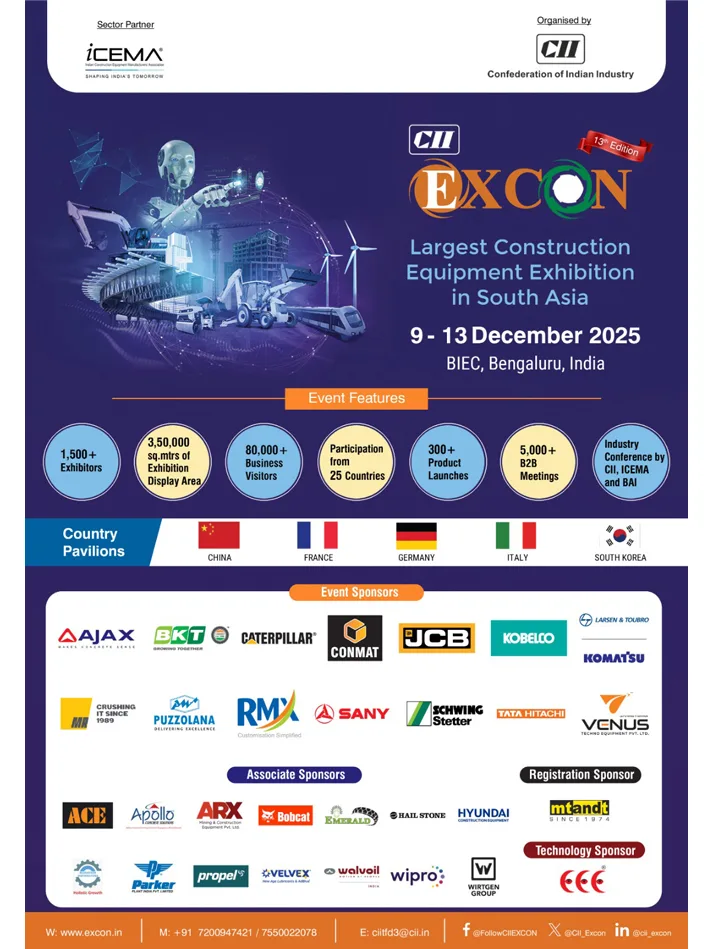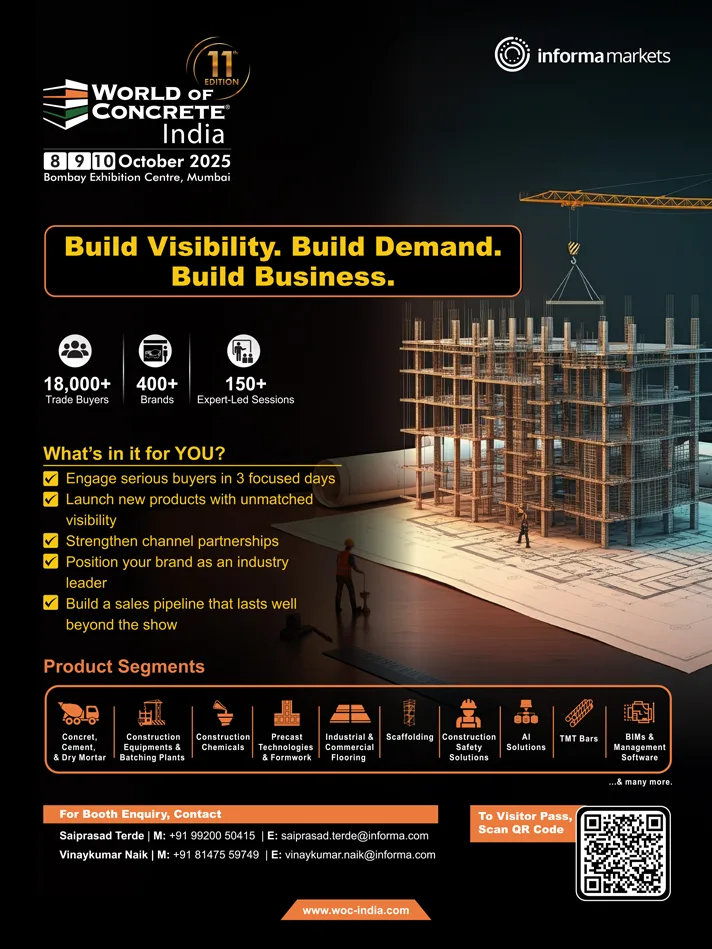
Construction PMS – Reigning Era of Enhanced Efficiency
According to a report by McKinsey, the construction industry is worth more than $10 trillion a year, equivalent to 13% of the world’s GDP. And just by digitization, the market capitalization can be raised by $1.6 trillion a year, which will make construction one of the largest industries in the global economy. This is a strong case for implementing new age project management software in construction. The good news is that times are a changing and as the need for efficient coordination of resources and timelines is on the rise for timely construction of projects, construction companies are fast turning to PMS companies. With varied state-of-the-art project management software in the offing, the construction landscape is about to witness a huge transformation. Here’s tracking the changing times of construction PMS…writes, PRERNA SHARMA.
As per the research estimates of Allied Market Research, the global construction management software market size was valued at $9.3 billion in 2021, and is projected to reach $23.9 billion by 2031, growing at a CAGR of 10.2% from 2022 to 2031. The leading segment in the construction project management software market by deployment mode is the cloud. There are several reasons for the growth of the cloud-based segment. First, cloud-based solutions offer a number of advantages over traditional on-premises solutions, such as scalability, flexibility, and cost-effectiveness. Second, the construction industry is increasingly adopting cloud-based solutions across all industries. Third, the growing use of mobile devices and the internet is making it easier for construction professionals to access cloud-based solutions. Cloud-based solutions enable construction companies to access centralized data from remote locations, thus allowing them to access project data and collaborate with project teams. AI is becoming an increasingly prevalent trend within project management software to automate tasks, facilitate decision-making processes and identify risks; this trend will undoubtedly fuel market expansion over the coming years.
A number of factors have contributed to the tremendous expansion the construction project management software market has seen in recent years. First off, the utilization of digital technologies to improve project management efficiency has become necessary due to the growing complexity of building projects, which is caused by factors including urbanization, infrastructure development, and technology breakthroughs. The adoption of these software solutions has also been fueled by the growing need for improved cost control and risk management, as well as real-time collaboration and communication among project stakeholders, according to Verified Market Reports.
Further to this, there are many driving factors behind the growth of construction management software stated Market.us report. Modern projects have become more complicated as technologies advance and sustainability standards rise; adding another element is multiple stakeholder involvement and involvement of multiple stakeholders – these factors drive demand for project management software that streamlines the management process and increases efficiency. In order to remain competitive, construction project management software offers a solution by automating tasks, providing real-time data feeds, identifying risks early, and helping mitigate them effectively.
With increased attention being directed toward sustainability within the construction industry and project management software used to meet sustainability goals becoming ever more prominent, this trend will likely propel its expansion over the coming years.
According to Technavio, growing advancements in construction management software are a primary trend driving the market growth. Companies are trying to integrate this software with all types of estimation and accounting software for managing the entire construction business. Software companies are aiding this integration with the help of professional software teams that have experts. This integration is designed particularly for sub-contractors to enhance their productivity and increase profits. The integrated software enables end-users to purchase orders, change orders, as well as pull and populate employees. It can handle material costs, cost codes, and contracts. This integrated software enhances communication between the accounting staff and the employees (of the construction company) who are in the field significantly. Apart from integration, companies are launching advanced construction management software. This AI-enabled suite of solutions allows teams to control project changes, manage material supplier and subcontractor tasks, enhance communications and collaboration, streamline bidding processes, and improve document management.
Expanding scope of AI & ML
One of the significant challenges in construction management is that most of the processes require extensive manual effort and expertise. It starts with creating a realistic schedule, budget, resource allocation and finally optimizing these processes to drive the project to yield better results. However, the advancements in AI and ML will be a game changer in this field, according to Colliers.
Automated Schedule Generation and Predictive Schedule Analysis: AI algorithms can analyze project requirements, resource availability, and constraints to automatically generate project schedules. These algorithms consider various factors such as task dependencies, resource allocation, and critical paths to create comprehensive schedules that optimize project timelines. By automating this process, project managers can save substantial time and effort, allowing them to focus on higher-level decision-making and strategic planning.
ML models are trained using historical project data, including project schedules, and corresponding events. These models can then predict the likelihood and impact of various events on the project schedule. By analyzing the data, the models can identify potential schedule delays, bottlenecks, and critical paths. Project managers can use these insights to proactively adjust resources, allocate additional time, or modify the project plan to mitigate risks and maintain project timelines.
Real-Time Schedule Monitoring and Control: By integrating real-time data from various sources such as sensors, IoT devices, and project management software, AI algorithms can analyze the progress of different project tasks and compare them with the planned schedule. Machine learning models can detect patterns, trends, and anomalies in the data to provide accurate and timely insights into the project’s schedule status.
With this information, project managers can identify potential delays or schedule disruptions early on. They can make informed decisions regarding resource allocation, task prioritization, and schedule adjustments to ensure project milestones are met. Real-time schedule monitoring and control help optimize project performance, minimize delays, and improve overall project efficiency.
Predictive Risk Assessment: By analyzing historical project data, including risk events and their outcomes, ML algorithms can learn patterns and relationships to predict the likelihood and impact of future risks. ML models can also consider the interdependencies between risks and their potential cascading effects on the project. Predictive risk assessment empowers project managers to prioritize risks based on their severity and allocate resources and mitigation strategies accordingly. By proactively addressing potential risks, construction projects can reduce the likelihood of negative outcomes and improve overall project resilience.
Interesting gamut of new age products & services
In the construction industry, it is crucial to recognize that simply thinking you are in control is not the same as actually being in control. This is particularly important when you have a digital platform that connects data, providing valuable insights into both facts and risks. It is essential to understand that having access to this information can make a significant difference in managing your operations safely and effectively. By leveraging the power of a digital platform to gather and analyze data, companies can gain a deeper understanding of your operations and make informed decisions that will help them to achieve goals while minimizing risk.
In a groundbreaking development, Zepth announced the integration of Artificial Intelligence into its platform, marking a transformative leap in construction project management. The pioneering product, the “AI Risk Manager”, leverages the power of AGI with 40 AI agents to proactively identify potential risks, collaborating with each other, carrying out likelihood and impact assessments, and assisting in mitigation plans for the identified risks, thus enabling project managers to make data-driven decisions.
“Zepth stands at the forefront of the AI revolution, redefining the Common Data Environment with human-level intelligence through AGI. Our platform epitomizes intelligence, simplicity, and efficiency, designed for the modern world. Zepth’s AI-driven solutions are delivering extraordinary efficiency and precision to clients globally. The traditional big tech solutions, while once groundbreaking, now lag in a rapidly changing world. They are complex relics of a bygone era – no longer the best fit for today’s dynamic industry needs,” said Prasoon Shrivastava, Founder & CEO, Zepth.
Rebus announced the launch of CloseoutSoft, an end-to-end construction planning and execution software to manage all construction processes until project closeout digitally. “We want everyone to build the world beyond their client’s dreams. CloseoutSoft is here to enable this for every project delivery specialist everywhere. It is the perfect solution for the perfect environment,” stated Francis Christy Boy, MD & CEO, Rebus. The features include Secure Submittals and Document Management; In-built QA/QC Processes; Easy Handover Monitoring; Built-in Cost Control; Easy and Complete Asset Management; Area Readiness Analysis; and Post-Construction Facility Management.
CONSTRA’s Work Breakdown Structure (WBS) provides a comprehensive framework for managing construction projects. One of its notable advantages is the ability to update project progress and work trades based on the scheduled timeline. This means that as tasks and subtasks are completed, project managers and team members can easily record the progress in CONSTRA, aligning it with the planned schedule. By capturing progress updates in real-time, CONSTRA ensures that project stakeholders have accurate and up-to-date information about the project’s status. This allows for better decision-making, as any deviations or delays from the original plan can be promptly identified and addressed.
Additionally, CONSTRA’s ability to generate immediate reports based on the captured progress data is invaluable. These reports provide project managers with a clear overview of the project’s progress, highlighting completed tasks, pending activities, and any potential bottlenecks or risks. This enables proactive management and timely intervention, ensuring that the project stays on track and any issues are promptly resolved.
According to Autodesk officials, the adoption of Building Information Modelling (BIM) – project management software and other digital tools has the potential to revolutionize the way projects are conceived, planned, and executed. The integration of these technologies allows for real-time collaboration, streamlined communication, and data-driven decision-making.
For many construction companies, the design and construction phases on many of their projects happen simultaneously. This means a common data environment is absolutely critical when it comes to delivering projects safely, on time and on budget. Many companies adopt a common data environment (CDE) to execute digital project delivery methods adhering to BIM Level 3. Connecting documents and drawings to BIM models allows project collaborators to access everything digitally. Rather than printing out copies of drawings over and over again, teams are enabled to work entirely digitally and, as a consequence, can reduce project-related carbon dioxide emissions.
Tracking trends
Trends in the ever-changing field of construction project management software continue to influence the direction of the sector. Enhancement of decision-making processes is achieved through the integration of artificial intelligence and machine learning capabilities, with cloud-based solutions providing greater accessibility and flexibility. Furthermore, there is a rising focus on collaboration technologies, which facilitate smooth communication between project stakeholders and increase productivity and efficiency. According to Verified Market Reports, these trends include…
Cloud Migration: Cloud-based software solutions are becoming more and more prevalent in the market. This makes on-premise installations unnecessary, enhances accessibility across devices, and makes it easier for project stakeholders to collaborate in real time. Additionally, automatic upgrades and simpler data scalability provided by cloud-based solutions help businesses keep up with the newest features and handle expanding project demands.
Integration & Data Analytics: Building information modeling (BIM) and construction accounting software are two examples of industry-specific solutions that construction project management software is progressively connecting with. A comprehensive perspective of projects is made possible by this networked ecosystem, which also streamlines workflows and makes data-driven decision-making possible. The software’s advanced analytics features assist in identifying possible hazards, allocating resources optimally, and enhancing project delivery effectiveness.
Mobile Accessibility: As mobile technology develops, building project management is changing. From their smartphones or tablets, project managers, field personnel, and customers may access real-time project data, follow progress reports, and interact easily thanks to feature-rich mobile applications. At every level of the building process, this promotes greater on-site collaboration, enhances responsiveness to problems, and gives decision-making authority more quickly.
Capturing growth expanse
The growing need for real-time communication among construction professionals, the need for efficient risk management, and the rising demand for data security are some of the factors expected to augment the market’s growth. The need for improved collaboration among project teams, the increasing awareness of the benefits of construction project management software, and the rising demand for project monitoring, scheduling, and budgeting solutions are also expected to drive the growth of the global construction project management software market.
The rising trend of smart cities and new housing trends in the world enabled by digital technologies is expected to propel the market’s growth. The smart city focuses on better engagement of its citizens for eco-friendly resource utilization, social, and better relational capital while ensuring its quality and performance. Construction and design software helps in redefining the decision-making process in the construction of energy-efficient buildings and smart cities.
The increasing development of infrastructures and the growing need for better interior design and decoration is expected to boost market growth. It allows architects to take preventive measures, thereby minimizing rebuilding and remodeling construction projects. Moreover, with the advent of 5G and the increasing power of computational devices, VR applications in interior design solutions allow graphics to become more realistic and render fast. It helps construction and design software improve productivity gain by reducing dependency on documentation and paper works, which helps businesses minimize costs related to interior designing. Moreover, the construction and design software enable architects to prepare a comprehensive floor layout, including accurate measurements of doors, windows, flooring, walls, cabinets, lighting, and furniture.
Construction and design software increases the accountability and efficiency of construction businesses by streamlining their manual processes. Additionally, it helps with scheduling jobs & estimates, job costing, project management, punch listing, cost control and assessing risks associated with construction projects. Moreover, an increase in the number of infrastructure projects, integration with lean management processes, financial visibility, successful management, and timely completion of construction projects are also expected to bolster the demand for construction and design software over the forecast period.
In conclusion, Grand View Research projects that the emergence of advanced technology in the construction and design industry, such as Augmented Reality (AR), Virtual Reality (VR), drones, communication tools, and business information modeling, is projected to support construction and design software demand. The integration of these technologies enables viewing of elevations and dips at construction sites before the commencement of projects which helps to increase the safety of on-site personnel. Furthermore, these technologies support health and safety in the construction sector, encouraging office personnel to fulfill social distancing norms. Conversely, the rise in trends of remote working is facilitating several engineers and architectures to utilize the current construction software for the further development of their construction models.
Fast Facts
- Construction Project Management Software Market was valued at US$9.45 Billion in 2023 and is expected to reach US$21.67 Billion by the end of 2030 with a CAGR of 12.5% during the forecast period 2024-2030.
- Cloud solutions have quickly gained prominence within the construction industry due to their numerous benefits such as scalability, flexibility and cost-efficiency.
- AI technology has quickly become more widely utilized within construction project management software in order to automate tasks, facilitate decision-making processes and detect risks more accurately.
- Construction project management software has increasingly focused on sustainability goals in recent years and helps projects meet those targets more successfully.













